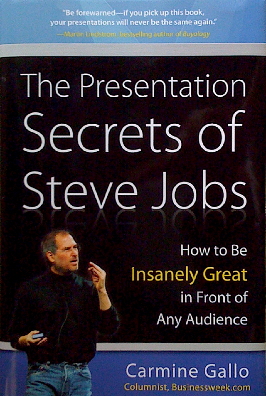|
|
The book arrived by mail four weeks after my online purchase (discounted to $17.56 plus $12.98 shipping). Ordering locally may be preferred. It was in perfect time for a trip to Kuala Lumpur where I was making a presentation. Even the first few pages made me realise how, despite much preparation, I could make improvements and I spent a frantic couple of days before the conference tweaking my presentation.
While the book does examine in a fair amount of detail how Jobs prepares for the keynote speeches, Gallo who is a presentation coach, brings in a fair amount of useful comparison, plus example, anecdote and analogy, much like the Bangkok Post's, Coach Kriengsak. However I found that perhaps too many digressions were interfering with the main idea. Also, like a good coach, Gallo highlights not just what is good, but also weaknesses. As such, he gives an example that I use in class: the short, hand-shaking, card-holding delivery given by Stan Sigman of AT & T (then Cingular) at the iPhone announcement. He is similarly amazed that an industry driver like Sigman made such a presentation which may be what he is remembered for, despite his other fine work. Gallo sets the book out like the five acts of a play, with scenes highlighting the skills that Steve Jobs brings to the floor. While this works to a large extent by allowing the reader to examine specifics, there are several asides, set off with thin lines. In David Pogue's "Missing Manual" series, such interludes are printed in grey boxes, while these are not clearly separated. Some are too long. Early in the book (Pp 18-19) the interlude took a complete double page and I found this confusing thinking initially that the printers had got it wrong. These need reorganising and shortening. The text has a number of properly annotated references, although some were missing, particularly a reference I presume is to Gallo's own input: "observed a BusinessWeek reporter". There is also a relatively short index.
The preparation starts weeks before and scores of people provide input. The massive amounts of data are condensed and the presentation developed from prioritised ideas. It is well known that Jobs rehearses, but in those sessions, he receives criticism from several sources, not the least of which is himself. Gallo has much on this honing of the performance that is the key to the professionalism displayed by Apple presenters.
It was clear from the conference I attended and from other presentations I have seen in the last few years that there is considerable room for improvement and that Gallo's book would be a useful resource for anyone who is tasked with making a presentation; or with teaching such skills.
|
|

 Gallo followed that in September 2009 with The Presentation Secrets of Steve Jobs in which he analyses the techniques more fully. I use presentations of Jobs (plus those of other Apple management, like Phil Schiller) when teaching these skills to my Thai students who normally look to teachers for style. Gallo has now added to my armoury.
Gallo followed that in September 2009 with The Presentation Secrets of Steve Jobs in which he analyses the techniques more fully. I use presentations of Jobs (plus those of other Apple management, like Phil Schiller) when teaching these skills to my Thai students who normally look to teachers for style. Gallo has now added to my armoury. But how does Steve do it? In effect there is no secret: it is just hard work. There are other significant aspects, like preparation, rehearsal and criticism; and the well-worn ideas of planning, starting with a piece of paper. It may also be a surprise to many, but the slides are prepared last.
But how does Steve do it? In effect there is no secret: it is just hard work. There are other significant aspects, like preparation, rehearsal and criticism; and the well-worn ideas of planning, starting with a piece of paper. It may also be a surprise to many, but the slides are prepared last.